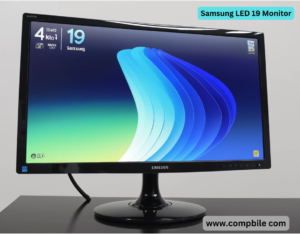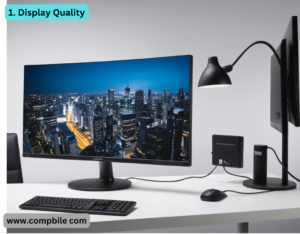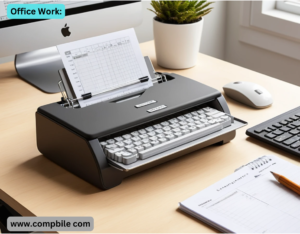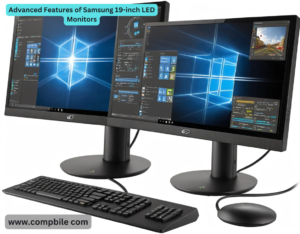Samsung LED 19 Monitor The Samsung LED 19 monitor is a compact and efficient display solution, ideal for everyday use, office work, or as a secondary screen. While specific models may vary, here are some general features you can expect from a Samsung 19-inch LED monitor:
Key Features:
- Screen Size: 19 inches (diagonal), offering a balance between space-saving design and comfortable viewing.
- Display Technology: LED backlighting for energy efficiency, better brightness, and improved color accuracy compared to older LCD monitors.
- Resolution: Typically 1366×768 (HD) or 1600×900 (HD+), suitable for general tasks like browsing, office work, and media consumption.
- Aspect Ratio: Usually 16:9 or 16:10, providing a widescreen viewing experience.
- Panel Type: Often uses TN (Twisted NEMATIC) or IPS (In-Plane Switching) panels, with IPS offering better color reproduction and viewing angles.
- Refresh Rate: Standard 60Hz, which is sufficient for everyday use and non-gaming tasks.
- Connectivity: Common ports include HDMI, VGA, and DVI, allowing compatibility with a variety of devices.
- Design: Slim and lightweight design with a minimal bezel, making it suitable for multi-monitor setups.
- Eye Care Features: Some models include flicker-free technology and blue light reduction to reduce eye strain during prolonged use.
- Energy Efficiency: LED monitors are known for their low power consumption, often meeting energy-saving standards like Energy Star.
Popular Models:
- Samsung S19F350: A 19-inch HD monitor with a slim design and PLS panel for wide viewing angles.
- Samsung S19D300: A basic 19-inch HD monitor with a TN panel, ideal for everyday use.
- Samsung LS19C30: A compact monitor with a glossy finish and HDMI connectivity.
Use Cases:
- Office Work: Great for spreadsheets, documents, and multitasking.
- Home Use: Suitable for browsing, streaming, and casual gaming.
- Secondary Monitor: Perfect as an extended display for laptops or desktops.
Detailed Features of Samsung 19-inch LED Monitors
1. Display Quality
- Resolution: Most 19-inch Samsung monitors come with HD (1366×768) or HD+ (1600×900) resolution. While not Full HD (1920×1080), this is sufficient for basic tasks like web browsing, document editing, and video playback.
- Brightness: Typically ranges from 200 to 250 cd/m², which is bright enough for well-lit environments.
- Contrast Ratio: Static contrast ratios are usually around 1000:1, with dynamic contrast ratios (if supported) being much higher.
- Color Accuracy: Entry-level models may have 6-bit color depth (16.7 million colors), while higher-end models with IPS panels offer better color reproduction.
2. Panel Technology
- TN Panels: Common in budget models, offering fast response times (5ms) but narrower viewing angles and less accurate colors.
- PLS/IPS Panels: Found in slightly more expensive models, providing wider viewing angles (178°) and better color accuracy, making them ideal for shared viewing or creative work.
3. Design and Build
- Bezel: Slim bezels on some models (e.g., Samsung S19F350) make them suitable for multi-monitor setups.
- Stand: Most models come with a basic tilt-adjustable stand, though height and swivel adjustments are rare in this size.
- VESA Mount Compatibility: Some models support VESA mounts (75x75mm or 100x100mm), allowing you to mount the monitor on a wall or arm.
4. Connectivity
- HDMI: Available on newer models for high-quality digital video and audio transmission.
- VGA: Found on older or budget models, useful for connecting to older PCs or laptops.
- DVI: Some models include DVI for digital video input.
- Headphone Jack: A few models feature a 3.5mm audio-out port for connecting headphones or speakers.
5. Eye Comfort Features
- Flicker-Free Technology: Reduces screen flickering, which can cause eye strain during long use.
- Blue Light Filter: Minimizes harmful blue light emissions, making it easier on the eyes during extended sessions.
6. Energy Efficiency
- Most Samsung 19-inch LED monitors are Energy Star certified, consuming significantly less power than older LCD monitors.
- Power consumption is typically around 15-20 watts during use and less than 0.5 watts in standby mode.
Popular Samsung 19-inch LED Monitor Models
Here are some specific models and their key features:
1. Samsung S19F350
- Panel Type: PLS (similar to IPS)
- Resolution: 1366×768 (HD)
- Features: Slim design, flicker-free technology, HDMI and VGA ports.
- Best For: General use, office work, and casual media consumption.
2. Samsung S19D300
- Panel Type: TN
- Resolution: 1366×768 (HD)
- Features: Glossy finish, basic design, VGA connectivity.
- Best For: Budget users or as a secondary monitor.
3. Samsung LS19C30
- Panel Type: TN
- Resolution: 1366×768 (HD)
- Features: HDMI and VGA ports, glossy screen.
- Best For: Home use or as a compact display for small spaces.
4. Samsung S19E200
- Panel Type: TN
- Resolution: 1366×768 (HD)
- Features: Ultra-slim design, eco-saving mode, VGA connectivity.
- Best For: Energy-conscious users or those with limited desk space.
Use Cases for a 19-inch Samsung LED Monitor
Office Work:
- Ideal for tasks like word processing, spreadsheets, and email.
- Compact size fits well in small workspaces.
Home Use:
- Great for browsing, streaming videos, and casual gaming.
- Energy-efficient and affordable.
Secondary Monitor:
- Perfect for extending your laptop or desktop screen for multitasking.
- Lightweight and easy to set up.
Education:
- Suitable for online classes, research, and document editing.
- Eye comfort features reduce strain during long study sessions.
How to Choose the Right Samsung 19-inch LED Monitor
Purpose:
- For basic tasks (e.g., office work, browsing), a TN panel model like the Samsung S19D300 is sufficient.
- For better color accuracy and viewing angles, opt for a PLS/IPS model like the Samsung S19F350.
Connectivity:
- Ensure the monitor has the ports you need (e.g., HDMI for modern devices, VGA for older systems).
Design:
- If you plan to use multiple monitors, choose a model with slim bezels (e.g., S19F350).
- For wall mounting, check for VESA compatibility.
Budget:
- Entry-level models like the Samsung S19D300 are affordable but lack advanced features.
- Mid-range models like the Samsung S19F350 offer better display quality and connectivity.
Tips for Optimizing Your Samsung 19-inch LED Monitor
Calibrate the Display:
- Use built-in presets (e.g., Standard, Movie, or Reading modes).
Use HDMI for Better Quality:
- If your device supports HDMI, use it instead of VGA for sharper images and audio transmission.
Enable Eye Comfort Features:
- Turn on the blue light filter and flicker-free settings to reduce eye strain.
Clean the Screen Regularly:
- Use a microfiber cloth and screen cleaner to maintain image clarity.
Advanced Features of Samsung 19-inch LED Monitors
While 19-inch monitors are generally entry-level, some models come with advanced features that enhance usability and performance:
1. Eco-Saving Mode
- Reduces power consumption by adjusting brightness and contrast automatically.
- Some models (e.g., Samsung S19E200) have a dedicated eco button for quick adjustments
2. Game Mode
- Enhances contrast and sharpness for a better gaming experience.
- While 19-inch monitors aren’t designed for hardcore gaming, this feature can improve visuals in casual game
3. Magic Bright and Magic Angle
- Magic Bright: Preset screen modes (e.g., Text, Internet, Movie) optimized for different tasks.
- Magic Angle: Adjusts the screen’s brightness and contrast based on your viewing angle (available in some PLS/IPS models).
4. Screen Split (Multi-Tasking)
- Some models (e.g., Samsung S19F350) support screen-splitting software, allowing you to divide the screen into multiple sections for multitasking.
5. Auto Source Switch
- Automatically detects and switches to an active input source (e.g., HDMI or VGA), making it easier to connect multiple devices.
Get article on pdf file…Click now
………….Samsung LED 19 Monitor……………





